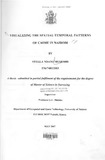| dc.description.abstract | Crime in Kenya is a serious problem with high social and economic costs. Crime is
neither unique nor random, but rather tends to be unevenly distributed and has a spatial temporal pattern. Geographic Information Systems (GIS) and crime mapping have
opened new opportunities in crime control and prevention. Unfortunately, many law
enforcement agencies, especially in the developing world, are not aware of this
technology and the strength it can bring to their work.
In this study, the spatial-temporal distribution of carjacking, robbery, burglary, murder
and rape in Nairobi between November 2004 and April 2005 have been analyzed using:
Point Pattern Mapping, Thematic Mapping, Spatial Ellipses, and Kernel Density
Estimation. 3D visualization of crime density surfaces was employed to assist in the
interpretation of these crime patterns. Changes in spatial distribution of crime during the
hour of the day, day of the week and month of the year were also determined and results
presented using graphs. The results indicate that Buruburu and Kasarani police divisions have the highest
concentration of crime hotspots. They also show that crime patterns in Nairobi vary with
time, the highest concentration being between 6pm and 12 am, with peaks at 8pm to 9
pm.
The study concludes that although Kernel density estimation is a good method for
identification of crime patterns, it is good to combine several methods to get the best
results and to curb crime, an exhaustive strategy focusing on all areas of crime
management is needed.
The study recommends increased reporting of crime, adoption of GIS techniques in
analysing crime patterns, capacity building in the Police Force and finally cooperation
and sharing of information between security organs, researchers, international
organizations and a regional approach in managing crime. | en |

